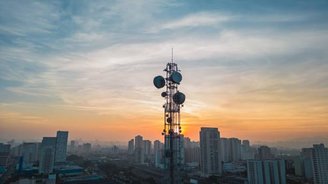Wi-Fi 7 is coming in 2024 to change the way we connect to the internet. Officially launched at CES 2024, the new generation of wireless networks promises to be the perfect solution for those looking for more speed and a connection without crashes.
If you use the internet to watch high-resolution videos, play games, or connect multiple devices at home or work, Wi-Fi 7 could be the next step.
But is it worth it? Let’s find out everything about this technology and how it can improve your online experience. Just read on!
What does Wi-Fi 7 mean?
Wi-Fi 7 is the new generation of wireless networks that will replace previous standards, such as Wi-Fi 6 (IEEE 802.11ax) and Wi-Fi 6E (IEEE 802.11ac). With its technical name IEEE 802.11be, the new standard promises to bring major improvements in terms of speed and efficiency.
The main advantage of Wi-Fi 7 is its ability to provide faster and more stable connections, making it ideal for scenarios with intensive use of connected devices.
 Wi-Fi 7 is the new standard for wireless networks around the world.Source: GettyImages
Wi-Fi 7 is the new standard for wireless networks around the world.Source: GettyImages
However, to take advantage of this technology, you need to have a router and devices compatible with Wi-Fi 7 — which is still not so easy to find on the current market!
What are the advantages of Wi-Fi 7?
At the moment, the 7th generation of Wi-Fi is considered by experts to be the most modern Wi-Fi in the world. The technology will support the frequencies of previous versions and deliver greater quality in the following aspects:
Grouped connections between bands
One of the great advantages of Wi-Fi 7 is the ability to group different frequency bands to optimize the connection. As with Wi-Fi 6 and Wi-Fi 6E, it uses the 2.4 GHz and 5 GHz frequencies, but with the addition of the 6 GHz band, exclusive to compatible devices.
With multilink operation (MLO technology), Wi-Fi 7 allows devices connect simultaneously to different frequencies and channelsensuring a more stable and high-speed connection, even in congested environments.
This brings a smoother experience for bandwidth-hungry applications like 8K streaming and online gaming.
Wi-Fi 7 Speed
Wi-Fi 7 represents a huge leap forward in speed compared to its predecessors. The new technology is designed to support bandwidth of up to 320 MHz, double what was possible with Wi-Fi 6.
The expansion allows for greater data transmission capacity, resulting in significantly faster download speeds. Specifically, Wi-Fi 7 can reach a maximum rated speed of up to 46 Gb/s – according to TP-Link.
Another innovation is quadrature amplitude modulation (QAM), which is a technique used to transmit data over radio waves. Wi-Fi 7 uses 4096-QAM, which is four times more efficient than Wi-Fi 6's 1024-QAM e o 256-QAM do Wi-Fi 5.
 Wi-Fi 7 delivers high performance for immersive augmented and virtual reality gaming and Internet of Things (IoT) devices.Source: GettyImages
Wi-Fi 7 delivers high performance for immersive augmented and virtual reality gaming and Internet of Things (IoT) devices.Source: GettyImages
Therefore, Wi-Fi 7 can carry much more information at once, increasing the overall speed of the network. These improvements translate into a much faster internet experience.
With Wi-Fi 7, for example, you can expect wireless data transfers of more than 2 GB per second, making heavy downloads easier and improving the performance of bandwidth-hungry applications like virtual reality (VR).
Lower latency
Wi-Fi 7 offers reduced latency, a crucial factor for internet performance in activities that require fast responses.
This benefit is particularly notable in online games, where the speed of communication between the server and the device can directly impact gameplay and competitiveness, in high-definition video conferences and other remote collaboration solutions.
Greater reach
Another improvement of Wi-Fi 7 is the increase in connection range. Compared to its previous versions, the Wi-Fi 7 is designed to cover a wider area e provide a stable connection in different environments.
You can enjoy more robust and reliable internet coverage throughout your home, office, and crowded locations like airports and shopping malls, even in areas that previously had weak or spotty signal.
Greater security
Wi-Fi 7 also improves the security of wireless networks by adopting the WPA3 encryption standard. This standard is superior to WPA2, which was used by Wi-Fi 5 and its predecessors.
O WPA3, ou Wi-Fi Protected Access 3, implementa more robust encryption protocols and offers stronger authentication, ensuring that your data and connections are more secure against intrusions and unauthorized access.
Competitiveness with 5G networks
Like 5G networks, Wi-Fi 7 has the potential to bring technological advances that promise to transform the online connections scenario in the world.
According to Eduardo Neger, director of the Brazilian Internet Association (Abranet), Wi-Fi 7 uses a new frequency band that enables impressive speeds, reaching up to 5 Gbps, thus surpassing the performance of 5G networks in terms of connection speed (via SBT).
 The new technology also paves the way for smooth integration with 5G networks.Source: GettyImages
The new technology also paves the way for smooth integration with 5G networks.Source: GettyImages
In Brazil, its implementation is seen by Abranet as a strategy to create a more efficient and flexible telecommunications infrastructureespecially with the recent release of the 1200 MHz band in the 6 GHz band by Anatel.
Best performance in the corporate scenario
Hélio Nobre, COO of SecureLink, highlights that one of the main benefits of Wi-Fi 7 is its ability to support a greater number of devices connected at the same time, without compromising connection quality.
“This is particularly relevant, above all, in offices that increasingly have IoT (Internet of Things) and Artificial Intelligence-based devices integrated into the IT infrastructure,” explains Nobre.
The Director of Operations also highlights that the use of Wi-Fi 7 can impact the way companies operate, “driving more efficient collaboration between teams distributed in different locations around the world”.
What is the difference between Wi-Fi 6 and Wi-Fi 7?
The main difference between the two generations is speed and efficiency. Wi-Fi 7 can reach speeds of up to 46 gigabits per second (Gbps), which is a huge improvement over Wi-Fi 6, which reaches up to 9.6 Gbps.
To get an idea of the difference, a router Wi-Fi 7 can download a large 15GB file in about 25 secondswhile the same download would take approximately 60 seconds with the best Wi-Fi 6 technology.
Additionally, Wi-Fi 7 is designed to deliver a smoother experience by reducing issues like buffering and lag.
If you are experiencing difficulties with your connection, adopting Wi-Fi 7 could be the solution to improve the quality of your connection and make the most of your online activities with high data demands.
Which devices have Wi-Fi 7?
According to the Wi-Fi Alliance, 2.1 billion Wi-Fi 7-compatible devices are expected to hit the market by 2028. Smartphones, PCs, tablets and access points (APs) will be the first to meet the new demand.
Companies such as TP-Link, Netgear and Eero have already announced Wi-Fi 7 router models. In the telephony sector, the OnePlus 11 5G, Samsung Galaxy S24 and iPhone 15 smartphones can support the seventh generation of wireless networks.
When will Wi-Fi 7 arrive in Brazil?
Wi-Fi 7 will make its debut in Brazil in August 2024, with its implementation at São José do Rio Preto Airport in São Paulo. This is the first location in the country to adopt the new connection standard, signaling the beginning of a new era for wireless networking technology in Brazil.
However, the supply of Wi-Fi 7 compatible products is still limited. The availability of these devices is expected to increase as the market adapts to the new technology.
Is it worth switching to Wi-Fi 7?
In addition to the router offering Wi-Fi 7, the devices that will be connected to it also need to support it. So, many home and office devices will need to be replaced to support the ultra-fast and stable Wi-Fi 7 connection.
This adaptation will require a high investment, as it is still expensive to have all the infrastructure needed to browse the internet and enjoy the Wi-Fi 7 experience.
Our final answer is: While Wi-Fi 7 devices are still new releases, it's worth holding off on waiting until the new standard becomes more accessible — unless you're a business with a large budget!
Did you like the content? Stay up to date with this and other information about technology here at TecMundo. Take the opportunity to understand if and possible to use free internet with VPN. Until next time!